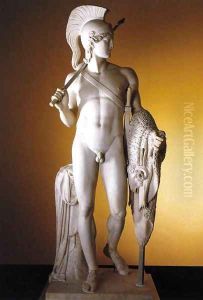Berthel Thorvaldsen Paintings
Bertel Thorvaldsen was a Danish sculptor of international fame, whose work is considered among the quintessences of Neoclassical art. Born on November 19, 1770, in Copenhagen, Denmark, to Icelandic parents, Thorvaldsen grew up in humble circumstances. His father, Gotskalk Thorvaldsen, was a wood carver, and this early exposure to artisanship undoubtedly influenced young Bertel's development as an artist.
Thorvaldsen was admitted to the Royal Danish Academy of Art when he was just 11 years old, and he excelled in his studies. In 1789, he won a gold medal for his sculpture, which afforded him the opportunity to travel to Rome to further his education. Arriving in Rome in 1797, Thorvaldsen quickly became a part of the city's vibrant art scene and was deeply influenced by the ancient Roman and Greek sculptures. He lived and worked in Rome for most of his life, where he produced a vast body of work that included statues, reliefs, and busts.
Thorvaldsen's works are characterized by their classical style, idealized forms, and restrained emotions, which were a departure from the more dramatic Baroque style that had dominated prior to his time. His sculptures often depicted mythological figures, heroes from antiquity, and historical personages. One of his most famous works is the statue of Jason with the Golden Fleece, which garnered him significant attention and established his reputation as a leading artist of the era.
Throughout his career, Thorvaldsen received numerous commissions from powerful figures of the time, including Napoleon Bonaparte and Pope Pius VII. His influence extended across Europe, and his works were widely collected and displayed. Notable among his creations are the series of statues representing the twelve apostles for the Vor Frue Kirke (Church of Our Lady) in Copenhagen, which is considered a national treasure in Denmark.
Thorvaldsen's legacy is preserved at the Thorvaldsen Museum in Copenhagen, which houses the largest collection of his works and was built to honor him. He returned to Copenhagen in the later years of his life, where he was received as a national hero. Bertel Thorvaldsen died on March 24, 1844, leaving behind a legacy that significantly impacted the art of sculpture and the Neoclassical movement. His artistic philosophy and creations continue to be studied and admired for their beauty and purity of form.
